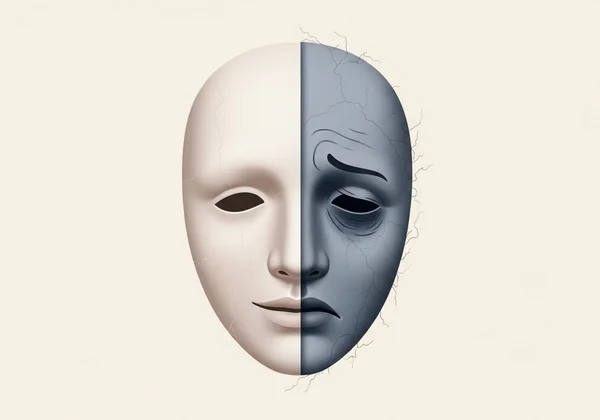CATQ & Undiagnosed Autism: Why High-Camouflaging Adults Miss Diagnosis
Do you ever feel like you're performing in your own life? As if you've been handed a script for social interaction that everyone else instinctively knows, while you're left meticulously studying your lines. This constant effort can be profoundly exhausting, leading many to wonder if there's a deeper reason for feeling "different." For countless adults, especially women, this experience is a hallmark of undiagnosed autism, masked by a lifetime of sophisticated social camouflaging. If you've ever asked yourself, how do I know if I'm masking autism?, you are not alone. We'll explore why this happens and how the CATQ can be a beacon on your journey to self-understanding. For those ready to begin, you can explore your results on our platform.
Understanding Autistic Camouflaging: The "Mask" You Wear
Autistic camouflaging, often called "masking," is essentially how we hide or compensate for our autistic traits to navigate a neurotypical world. It's a subconscious or conscious strategy developed to fit in, avoid negative attention, and build connections. This isn't about being deceptive; it's a survival mechanism born from a desire for acceptance and safety. Understanding this is the first step toward self-compassion.

What is Autistic Masking and Why Do We Do It?
Autistic masking involves a complex set of strategies. These can be broadly understood through the three pillars measured by the Camouflaging Autistic Traits Questionnaire (CATQ):
- Compensation: This is the strategic part of masking. It involves actively learning and applying social "rules." You might practice conversations in your head, prepare jokes beforehand, or consciously remind yourself to make eye contact. It’s like being a social detective, constantly gathering clues to perform successfully.
- Masking: This involves hiding your natural autistic behaviors and stims. You might suppress the urge to fidget, force a smile when you're overwhelmed, or hide your intense interest in a specific topic to appear more "mainstream." It’s a direct suppression of your authentic self.
- Assimilation: This is the act of trying to blend in completely by imitating others. You might adopt the mannerisms, tone of voice, or even the opinions of those around you to avoid standing out. This can lead to a profound sense of losing your own identity.
These behaviors often develop in childhood as a way to cope with social environments not always designed for neurodivergent minds.
Common Signs of High Camouflaging in Daily Life
The signs of autistic camouflaging are often subtle and can be easily mistaken for shyness, introversion, or social anxiety. You might recognize yourself in these examples:
- Feeling completely drained after social events, needing long periods alone to recover.
- Scripting phone calls or practicing for meetings for hours.
- Manually controlling your facial expressions and body language to appear "interested" or "relaxed."
- Relying on a "social persona" at work or with friends that feels disconnected from your true self.
- Finding small talk utterly baffling and exhausting.
- Feeling intense anxiety about being "found out" or seen as strange.
If these resonate, it might be a sign that you're investing enormous energy into camouflaging. A great starting point for clarity is an autistic masking test.
Why Many Autistic Adults Go Undiagnosed, Especially Women
One of the most significant challenges in the world of autism is the prevalence of undiagnosed autism in adults, a phenomenon that disproportionately affects women and gender-diverse individuals. For decades, the model for autism was based almost exclusively on young, white boys. This created a narrow diagnostic stereotype that many high-camouflaging individuals, particularly women, simply don't fit.

The Unique Presentation of Autism in Women
Research consistently shows that high functioning autism in women often presents very differently. Autistic girls and women tend to have more socially-focused special interests (like psychology, literature, or animals) that are less likely to be flagged as "autistic." They are often highly motivated to build friendships and may develop incredibly sophisticated camouflaging skills from a young age.
This internalised presentation—where the struggle is more mental and emotional than behavioral—means they often fly under the radar of parents, teachers, and even clinicians. They might be seen as "shy," "quirky," or "intense," but their underlying neurotype is missed entirely. This is where a tool like the cat q test can provide invaluable data points for self-reflection.
The Overlap with Other Conditions: Misdiagnosis Factors
The immense effort of constant camouflaging takes a significant toll, often leading to co-occurring mental health conditions. Many autistic adults, especially women, are first diagnosed with anxiety, depression, obsessive-compulsive disorder (OCD), or even borderline personality disorder.
While these conditions are very real, they are often a consequence of living in a world not built for them and the stress of masking their authentic selves. The root cause—the underlying autism—remains unaddressed, leaving the individual without the right tools and understanding to truly thrive.
The Silent Toll: The Impact of Constant Masking & Undiagnosed Traits
Living behind a mask is not a sustainable way to exist. The energy required is immense, and over time, it can lead to severe consequences for mental and physical health. This is a critical pain point for many who seek out information on the CATQ.

Chronic Exhaustion and Autistic Burnout
One of the most debilitating consequences of long-term camouflaging is autistic burnout. This is not just feeling tired; it's a state of profound exhaustion that impacts every facet of life. It can manifest as a loss of skills, increased sensory sensitivity, chronic fatigue, and an inability to cope with daily demands that were previously manageable.
Autistic burnout is the direct result of the cumulative stress of navigating a neurotypical world and suppressing one's true self. It's the body and mind finally saying, "I can't do this anymore." Understanding your camouflaging behaviors through a structured assessment can be the first step toward preventing or recovering from burnout.
Mental Health Challenges and Identity Confusion
When you spend your entire life performing a role, it can become incredibly difficult to know who you are underneath the mask. This can lead to deep-seated identity confusion, low self-esteem, and a persistent feeling of being an imposter in your own life. You might feel disconnected from your own emotions and achievements.
This internal conflict is a significant source of anxiety and depression. Gaining a framework for why you feel this way—understanding your neurotype—can be incredibly validating. It shifts the narrative from "What's wrong with me?" to "This is how my brain works, and that's okay."
Discovering Your Neurotype: How the CATQ Can Help
If this article resonates with you, you're likely searching for answers and validation. The Camouflaging Autistic Traits Questionnaire, or CATQ, is a scientifically validated tool designed precisely for this purpose. It provides a private, accessible way to quantify the social camouflaging strategies you may have been using your whole life.

The CATQ as a Tool for Self-Understanding and Validation
The CATQ online test isn't a diagnostic tool, but it is a powerful instrument for self-discovery. By answering the 25 questions, you can receive a score that reflects your levels of Compensation, Masking, and Assimilation. Seeing these behaviors quantified can be an incredibly validating experience.
It offers a concrete way to describe feelings you might have struggled to articulate. This new understanding is the foundation for self-acceptance and can be a crucial piece of evidence to bring to a mental health professional if you choose to seek a formal diagnosis. Are you ready for this clarity? Take the test now.
Beyond the Score: Harnessing AI Insights for Deeper Clarity
On our platform, we go one step further. After completing the free assessment, you have the option to unlock a personalized AI-powered report. This report analyzes your unique pattern of responses to provide deep insights into your personal strengths, challenges, and how your camouflaging may be impacting specific areas of your life, from the workplace to your relationships.
It's more than just a number; it's a personalized guide to help you truly understand your own mind. It offers actionable advice and strategies tailored to your profile, empowering you to make conscious choices about when and how you use your energy, paving the way toward a more authentic life.
Your Journey to Unmasking and Self-Acceptance Starts Here
Realizing you might be a high-camouflaging autistic adult isn't an endpoint; it's a new beginning. It's the start of a journey toward self-compassion, acceptance, and building a life that truly honors your neurotype. The exhaustion, confusion, and feeling of being an outsider all have a reason—and you have the power to rewrite your story.
Taking the first step can be the hardest part, but it's also the most rewarding. We invite you to start your free assessment and gain the clarity you deserve. Explore your results, consider our unique AI insights, and begin your path toward a more authentic you.
Frequently Asked Questions About Autistic Camouflaging & Self-Discovery
What is the CATQ test, and how does it relate to masking?
The CATQ test, or Camouflaging Autistic Traits Questionnaire, is a scientifically validated self-report measure created by Hull et al. (2018). It's designed to quantify the specific behaviors people use to mask or camouflage their autistic traits in social situations. It gives you a score across three areas—Compensation, Masking, and Assimilation—to help you understand the extent and style of your camouflaging.
How do I know if I'm masking autism, or just socially awkward?
While there can be overlap, the key difference often lies in the mental effort and subsequent exhaustion. Social awkwardness might involve occasional missteps, but autistic masking is a constant, conscious process of monitoring, performing, and suppressing your natural self. If social interactions consistently leave you feeling drained as if you've run a marathon, and you spend significant time preparing for and recovering from them, you may be masking. The CATQ online test can help you explore this distinction further.
Can I be autistic and not know it, especially if I've been successful?
Absolutely. This is especially common for high functioning autism in women and other high-camouflaging individuals. Many autistic people are highly intelligent and successful in their careers. Their success often comes at a great personal cost, powered by sophisticated masking strategies that hide their internal struggles. Success does not invalidate the possibility of being autistic; in fact, it can sometimes be a byproduct of the intense focus and pattern-recognition skills common in autism.
What is a high score on the CATQ, and what does it indicate?
According to the original research, a total score on the CATQ of 100 or above is a strong indicator of significant camouflaging. A high score suggests that you invest a substantial amount of energy in hiding your autistic traits to fit into social environments. It is not a diagnosis of autism, but it is a powerful piece of data that validates the experience of masking and is often correlated with being on the autism spectrum. To understand your personal score, you can try our free tool.
Disclaimer: This article is for informational and self-exploration purposes only. The CATQ is a screening tool, not a diagnostic instrument. It cannot replace a professional evaluation by a qualified healthcare provider.```